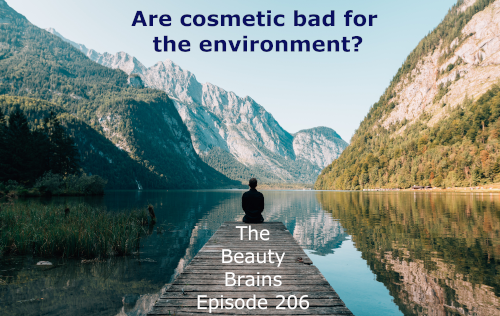Beauty Science News stories
On today’s program we are going to talk about a couple of beauty industry news stories and answer your questions about…
- Aluminum hydroxide in topical products
- Whether lip scrubs are worthwhile
- The environmental impact of cosmetics
- And what the differences are between bentonite and charcoal in a facial mask
Beauty Science News
Talc is not linked to cancer – I wonder if that will affect the court cases
Regenerative beauty: Aussie skin care brand sees luxury potential in horse placenta
There is a challenge with using ingredients that are derived from animal protein, fat, tallow, placenta, etc, and that is transmissible spongiform encephalopathy, also known as TSE when speaking about animals in general, or BSE when speaking about cattle.
Recall Alert
Say Yes To Recalls their Yes to Grapefruit VITAMIN C GLOW-BOOSTING UNICORN PEEL-OFF MASK.
Ingredient list: Water (Aqua), Ethyl Alcohol, Glycerin, Algin, Titanium Dioxide (CI 77891), Citrus Grandis (Grapefruit) Seed Extract, Mica, Ascorbic Acid*, Polyvinyl Alcohol, Tin Oxide (CI 77861), Ethylhexylglycerin, Chlorphenesin, Silica, Phenoxyethanol, Fragrance (Parfum), Benzyl Benzoate, Limonene. *Vitamin C
Beauty Questions
Question 1 – Jodi from LA – What is aluminum hydroxide and is it bad if it is in a diaper rash cream?
Aluminum hydroxide is an approved active ingredient to treat diaper rash. It has been approved as safe and effective at a level of up to 5%. This means that the product has gone through medical trials and been proven to be safe & effective. It has an absorbant effect which makes it work. It also has no known skin toxicity so there isn’t anything to worry about.
However, people hear the word “aluminum” and they automatically get scared. There is no reason to be scared but unfortunately, fear-marketers have made people afraid of anything with aluminum, especially antiperspirants and products that are applied to the skin of babies. But these ingredients have been tested and they are safe. I don’t know how to convince people that think otherwise though.
Question 2 – Ben A La Mode (Instagram) – I feel that lip scrubs and masks are all the rage these days, and I am not sure if they have long term benefits. I know that a scrub may make lips feel soft in the moment, but will they make my lips feel and look younger over time? Which ingredients are good for these scrubs and moisturizers to have?
Question 3 Wahde was wondering if we could help with a paper he wanted to write on the impact of cosmetic use and the environment. He says, can you please help by providing info for contributing factors that identify cosmetics as an environmental health problem? And consequences that would arise if the problem is left unsolved or unsolved. Anything will help! Thank you so much!
There are a few ways in which cosmetics impact the environment. They include…
- Chemicals getting into our waterways
- Toxic chemicals
- Microplastics
- Air pollution
- Plastic going into landfills
What can consumers do? I don’t really know. I saw the advice that people should make their own cosmetics but this isn’t such a great idea. If you are going to use stuff in your kitchen to make cosmetics they aren’t going to work as well as a standard product. Now, you can buy cosmetic ingredients from home crafter suppliers but if you add up the environmental impact of making it yourself, that’s also not going to be better for the environment. I guess the best that you might be able to do is to buy fewer products and buy from companies that have transparent sustainability programs. And just remember, just because a company says they are environmentally friendly doesn’t automatically mean they are. Cosmetic companies are still in the business to get you to buy more and more product. Even the environmentally friendly ones.
Question 4 – Ravi asks, What are the differences between the mechanism of charcoal and bentonite when they work on your face in cosmetic products?
I couldn’t find any literature about which had more absorbing capacity, but in general, you would use a higher percentage of bentonite in a formulation so I would imagine that you have more absorption capacity. Additionally, I couldn’t find any literature about topical application of charcoal and the adsorption benefits, just the ingestion. However, suppliers of bentonite have done studies about sebum reduction and removal of iron from the skin, while adding beneficial trace minerals like magnesium and silicon.
Follow the Brains
Thanks for listening. Hey if you get a chance can you go over to iTunes and leave us a review. That will help other people find the show and ensure we have a full docket of beauty questions to answer.
ASK A QUESTION – If you want to ask a question click this link or record one on your phone and send it to thebeautybrains@gmail.com
Social media accounts
on Instagram we’re at thebeautybrains2018
on Twitter, we’re thebeautybrains
And we have a Facebook page.
Support the Beauty Brains!
The Beauty Brains are now on Patreon! Help support us to continue to make episodes.
Thanks again for listening and remember Be Brainy about your Beauty

